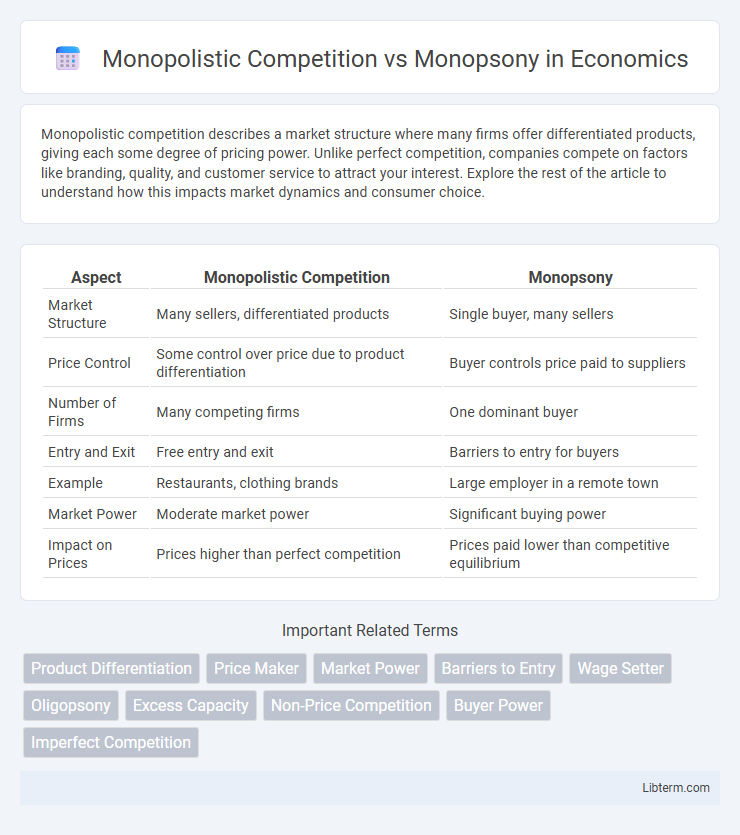Monopolistic competition describes a market structure where many firms offer differentiated products, giving each some degree of pricing power. Unlike perfect competition, companies compete on factors like branding, quality, and customer service to attract your interest. Explore the rest of the article to understand how this impacts market dynamics and consumer choice.
Table of Comparison
| Aspect | Monopolistic Competition | Monopsony |
|---|---|---|
| Market Structure | Many sellers, differentiated products | Single buyer, many sellers |
| Price Control | Some control over price due to product differentiation | Buyer controls price paid to suppliers |
| Number of Firms | Many competing firms | One dominant buyer |
| Entry and Exit | Free entry and exit | Barriers to entry for buyers |
| Example | Restaurants, clothing brands | Large employer in a remote town |
| Market Power | Moderate market power | Significant buying power |
| Impact on Prices | Prices higher than perfect competition | Prices paid lower than competitive equilibrium |
Introduction to Market Structures
Monopolistic competition features many sellers offering differentiated products, enabling some control over prices while maintaining competition. In contrast, a monopsony exists when a single buyer dominates the market, influencing prices and terms from the purchasing side. These market structures differ fundamentally in the distribution of market power between buyers and sellers.
Defining Monopolistic Competition
Monopolistic competition is a market structure characterized by many firms selling products that are similar but not identical, allowing for product differentiation and some degree of pricing power. It contrasts with a monopsony, where a single buyer controls the market and influences price and demand. In monopolistic competition, firms compete on non-price factors such as quality, branding, and customer service, leading to a diverse range of choices for consumers.
Understanding Monopsony
Monopsony occurs when a single buyer dominates the market, exerting significant control over suppliers and driving prices below competitive levels. This market structure often results in reduced supplier wages or input costs, limiting suppliers' market power compared to the concentrated buyer. Understanding monopsony highlights its impact on labor markets and input sourcing, distinct from monopolistic competition where many sellers compete with differentiated products.
Key Differences Between Monopolistic Competition and Monopsony
Monopolistic competition involves many sellers offering differentiated products, leading to some price-setting power and non-price competition, while a monopsony features a single buyer dominating the market, controlling purchase prices and quantities. In monopolistic competition, firms face downward-sloping demand curves due to product differentiation, whereas a monopsonist faces an upward-sloping supply curve, adjusting input prices to influence procurement. Market outcomes in monopolistic competition typically show excess product variety and moderate pricing power, contrasting with monopsony scenarios where buyer power can suppress input prices and reduce supplier welfare.
Characteristics of Firms in Monopolistic Competition
Firms in monopolistic competition are characterized by many competitors selling differentiated products, allowing them some degree of market power to set prices. Each firm faces a downward-sloping demand curve due to product differentiation, leading to non-price competition through advertising and innovation. Entry and exit are relatively easy, resulting in zero economic profit in the long run as firms adjust to market conditions.
Buyer Power in a Monopsony Market
In a monopsony market, buyer power is concentrated in a single or dominant purchaser, enabling significant control over prices and terms of purchase. Unlike monopolistic competition where many buyers face many sellers with limited price influence, a monopsonist can dictate lower prices and influence supply decisions due to lack of alternative buyers. This buyer dominance often leads to reduced input costs but can suppress supplier profitability and market entry.
Pricing Strategies in Both Market Structures
Monopolistic competition features many firms selling differentiated products with some degree of price-setting power, leading to pricing strategies that rely heavily on product differentiation, advertising, and perceived quality to maintain market share. In contrast, a monopsony consists of a single dominant buyer controlling demand, which allows it to influence prices paid to suppliers by leveraging its purchasing power to negotiate lower input costs. Pricing strategies in monopolistic competition emphasize maximizing profit through consumer preferences and brand loyalty, whereas a monopsony focuses on minimizing expenditure by exploiting its sole-buyer status to set input prices below competitive equilibrium levels.
Real-World Examples of Monopolistic Competition and Monopsony
In monopolistic competition, companies such as restaurants and clothing brands exhibit product differentiation while competing within a large market, offering consumers diverse choices. In contrast, a monopsony appears in labor markets like major sports leagues where a single or few employers hold significant power over wage-setting and employment conditions. Real-world examples highlight how monopolistic competition drives innovation and variety, whereas monopsony results in buyer power that can suppress wages and limit supplier options.
Impact on Consumers and Producers
Monopolistic competition features many firms offering differentiated products, allowing consumers greater choice and fostering innovation, though prices tend to be higher than in perfect competition. Producers in monopolistic competition benefit from some market power, which can lead to increased profits but also inefficiencies due to excess capacity. In contrast, monopsony describes a market with a single buyer exerting significant control over prices, often leading to lower input costs for producers but reduced wages and options for labor or suppliers, negatively impacting consumer welfare through restricted market competition.
Regulatory and Policy Implications
Regulatory frameworks addressing monopolistic competition emphasize promoting product differentiation and consumer choice, often implementing antitrust laws to prevent market dominance and collusion. In contrast, policies targeting monopsony power focus on protecting labor markets and suppliers from buyer exploitation, enforcing wage standards and fair contracting practices to counteract buyer-side market control. Understanding these distinctions is critical for tailoring regulations that balance competitive dynamics while preventing market abuses in both supply and demand sides.
Monopolistic Competition Infographic

 libterm.com
libterm.com